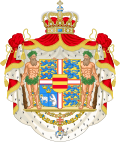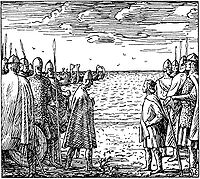- Magnus I of Norway
-
Magnus the Good 
Coin of Magnus I. King of Norway Reign 1035–1047 Predecessor Cnut the Great Successor Harald Hardrada King of Denmark Reign 1042–1047 Predecessor Harthacnut Successor Sweyn II House Fairhair Father Olaf Haraldsson (St. Olaf) Mother Alvhild (concubine) Born April/June 1024
NorwayDied 25 October 1047 (aged 23)
ZealandBurial Trondheim Religion Roman Catholicism Magnus I (April/June 1024 – 25 October 1047), known as the Good or the Noble, was the King of Norway from 1035 to 1047 and the King of Denmark from 1042 to 1047. He was an illegitimate son of king Olaf II of Norway, but fled with his mother in 1028 when his father was dethroned. In 1035 he returned to Norway and was crowned king at the age of 11. In 1042, he was crowned king of Denmark. Magnus ruled the two countries until 1047, when he died under unclear circumstances.
Contents
Biography
Magnus was the illegitimate son of Olaf II of Norway, later known as Saint Olaf, by his English concubine Alfhild.[1] According to Snorri Sturluson's Heimskringla, he was named Magnus (Magnús in Old Norse) by Sigvatr Þórðarson, his father's Icelandic skald, after Charlemagne, Carolus Magnus in Latin.[2]
In 1028 Olaf was dethroned by the Danish king Cnut the Great, and Magnus and his mother went with Olaf into exile in Garðaríki.[1] Olaf died 1030; Magnus remained with his mother in exile in Kievan Rus'. However, after the death of Cnut the Great in 1035, the Norwegian noblemen did not want to be under Danish rule any longer, in particular the oppressive rule of Cnut's son Svein and his mother Ælfgifu (known as Álfífa in Norway).[3] Einarr Þambarskelfir and Kalf Arnesson, Magnus' father's ally and the enemy commander from Stiklestad, went together to Gardariki to bring the boy back to rule as King of Norway.[4]
King of Norway and Denmark
Magnus was proclaimed king in 1035, at 11 years of age, and Svein and his mother fled; Svein died shortly after. At first Magnus sought revenge against his father's enemies, but on Sigvat's advice he stopped doing so, which is why he became known as "good" or "noble".[4]
Another son of Cnut, Harthacnut, was on the throne of Denmark and wanted his country to reunite with Norway, while Magnus initiated a campaign against Denmark around 1040.[5] However, the noblemen of both countries brought the two kings together at the Göta River, the border between their kingdoms. They made peace and agreed that the first of them to die would be succeeded by the other.[6][7] In 1042 Harthacnut died while in England, and Magnus also became King of Denmark, in spite of a claim by Cnut's nephew Sweyn Estridsen, whom Harthacnut had left in control of Denmark when he went to England,[6] and who had some support.
As part of consolidating his control, Magnus destroyed the Jomsborg, headquarters of the Jomsvikings. Sweyn fled east and returned as one of the leaders of an invasion by the Wends in 1043, which Magnus decisively defeated at the Battle of Lyrskov Heath, near Hedeby.[7][8] In the battle, Magnus wielded Saint Olaf's battle-axe, named Hel after the goddess of death.[7][9] He had dreamed of his father the night before, and the Norwegians swore that before the battle they could hear the bell that Saint Olaf had given to the church at Kaupang - a sign that the saint was watching over his son and the army.[10] It was the greatest victory ever over the Wends, with up to 15,000 killed.
Sweyn continued to oppose Magnus in Denmark, although according to Heimskringla, they reached a settlement by which Sweyn became Earl of Denmark under Magnus.[11]
Magnus wanted to reunite Cnut the Great's entire North Sea Empire by also becoming king of England. When Harthacnut died, the English nobles had chosen as their king Æthelred the Unready's son Edward (later known as Edward the Confessor); Magnus wrote to him that he intended to attack England with combined Norwegian and Danish forces and "he will then govern it who wins the victory."[12] The English were mostly hostile to Magnus; Sweyn was made welcome there, although Edward's mother, Emma, curiously favored Magnus and in 1043 the king confiscated her property, with which by one report she had promised to assist Magnus.[13]
Meanwhile, Magnus' uncle Harald Hardrada had returned to Norway from the east and contested his rule there, while Sweyn was still a threat in Denmark; Harald allied himself with Sweyn.[1] Magnus chose to appease Harald,[1] and made him his co-king in Norway in 1046.[14][15]
Physical Appearance
Snorri describes Magnus as:
of middle height, with regular features and light complexion. He had light blond hair, was well-spoken and quick to make up his mind, was of noble character, most generous, a great warrior, and most valorous."[16]
Death
Sweyn increased the pressure on Magnus from his base in Scania,[5] but by late 1046, Magnus had driven Sweyn out of Denmark. However, on October 25, 1047 he died suddenly while in Denmark, either in Zealand or in Jutland, either in an accident or of a disease; accounts vary.[17] Reports include falling overboard from one of the ships he was mustering to invade England and drowning,[7] falling off a horse,[18] and falling ill while on board a ship.[1] He is said to have made Sweyn his heir in Denmark, and Harald in Norway; some say in a deathbed statement.[1] Magnus was buried with his father in the cathedral at Nidaros, modern Trondheim.[1]
The line of Olaf II ended with Magnus' death. However, in 1280 Eric II of Norway, who was descended through his mother from Magnus' legitimate sister, Wulfhild, was crowned king of Norway.
Magnus was not married, but had a daughter out of wedlock, Ragnhild, who married Håkon Ivarsson, a Norwegian nobleman. Her great-grandson Eric III of Denmark would become King of Denmark.
Ancestry
Ancestors of Olaf I of Denmark16. Bjørn Farmann 8. Gudrød Bjørnsson 4. Harald Grenske 2. Olaf II of Norway 10. Gudbrand Kula 5. Åsta Gudbrandsdatter 1. Magnus I of Norway 3. Alfhild Notes
- ^ a b c d e f g Carl Frederik Bricka, Dansk Biografisk Lexikon, vol. XI [Maar - Müllner], 1897, p.44.
- ^ Lee Milton Hollander (Trans.), Heimskringla: History of the Kings of Norway. University of Texas Press, 1964. ISBN 0292730616, p. 390.
- ^ Frank Stenton, Anglo-Saxon England, 3rd ed. Oxford: 1971, ISBN 19-821716-1, pp. 405-06.
- ^ a b Karen Larsen, A History of Norway, Princeton University Press, 1950, p. 110.
- ^ a b Monarkiet i Danmark - Kongerækken at The Danish Monarchy
- ^ a b Larsen, p. 113.
- ^ a b c d Palle Lauring, A History of the Kingdom of Denmark, tr. David Hohnen, Copenhagen: Høst, 1960, pp. 57-59.
- ^ Hjalmar Horth Boyesen, The Story of Norway, New York: Putnam, 1889, p. 237.
- ^ Hollander (Trans.), Heimskringla, p. 562.
- ^ Hollander (Trans.), Heimskringla, p. 561.
- ^ Hollander (Trans.), Heimskringla, p. 558.
- ^ Larsen, p. 114.
- ^ Stenton, pp. 426-27.
- ^ Hollander (Trans.), Heimskringla, pp. 593-96.
- ^ Larsen, p. 111.
- ^ Hollander (Trans.), Heimskringla, p. 600.
- ^ Gwyn Jones, A History of the Vikings, London: Oxford University Press, 1973, ISBN 0-19-285063-6, p. 406.
- ^ Knut Gjerset, History of the Norwegian People, Volume 1, New York, Macmillan, 1915, p. 279.
Sources
- Saga Hákonar góða from Snorri Sturluson's Heimskringla in Old Norse, ed. N. Linder and H. A. Haggson, online at Kulturformidlingen Norrøne Tekster og Kvad, Norway.
- Saga of Magnus the Good from Heimskringla, translated by Samuel Laing, online at the Online Medieval and Classical Library.
- Heimskringla in Icelandic, Norwegian, and English, online at Idar Lind's "Norrøn Mytologi/Norrøn Tid."
- Saxo Grammaticus' Gesta Danorum, Book X chapters 21 and 22, online at Royal Danish Library.
Magnus the GoodBorn: April/June 1024 Died: 25 October 1047Regnal titles Preceded by
Sveinn Alfífuson
& Canute the GreatKing of Norway
1035–1047Succeeded by
Harald HardradaPreceded by
HarthacnutKing of Denmark
1042–1047Succeeded by
Sweyn EstridssonMonarchs of Denmark Early monarchs (Harthacnut) · Gorm the Old · Harald Bluetooth · Sweyn Forkbeard1 · Harald II · Cnut the Great1 · Harthacanute1 · Magnus the Good · Sweyn II · Harald III · Canute the Saint · Olaf I · Eric Evergood · Niels · Eric the Memorable · Eric Lamb · Sweyn Grathe / Canute V / Valdemar the Great · Canute VI · Valdemar the Victorious / Valdemar the Young · Eric Plough-tax · Abel · Christopher I · Eric Klipping · Eric Menved · Christopher II · Valdemar III · Christopher II · Interregnum · Valdemar Atterdag · Olaf II · Margaret I2
Palatinate-Neumarkt 1397–1448Oldenburg 1448–1863Christian I2 · John2 · Christian II2 · Frederick I · Christian III · Frederick II · Christian IV · Frederick III · Christian V · Frederick IV · Christian VI · Frederick V · Christian VII · Frederick VI · Christian VIII · Frederick VIISchleswig-Holstein-
Sonderburg-Glücksburgsince 1863Categories:- Danish monarchs
- Norwegian monarchs
- Fairhair dynasty
- Viking Age monarchs
- Medieval child rulers
- Roman Catholic monarchs
- 1024 births
- 1047 deaths
- Burials at Nidaros Cathedral
Wikimedia Foundation. 2010.


